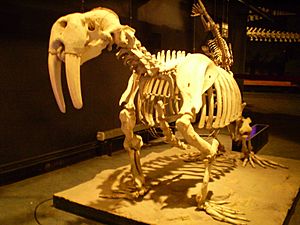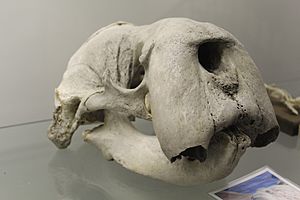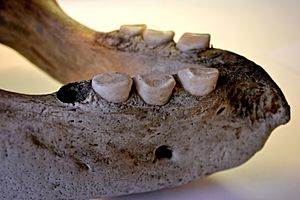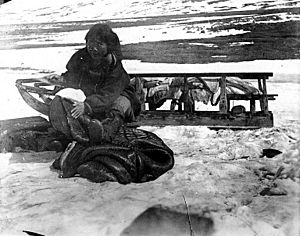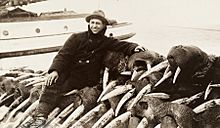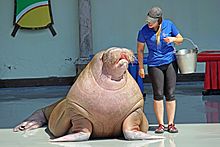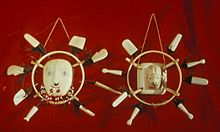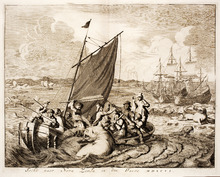Walrus facts for kids
Quick facts for kids WalrusTemporal range: Pleistocene to Recent
|
|
|---|---|
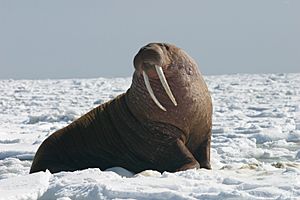 |
|
| Male Pacific walrus | |
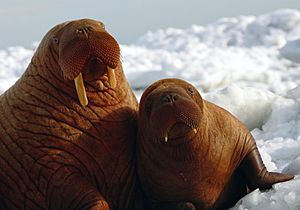 |
|
| Female Pacific walrus with young | |
| Conservation status | |
| Scientific classification | |
| Genus: |
Odobenus
|
| Species: |
rosmarus
|
| Subspecies | |
|
O. rosmarus rosmarus |
|
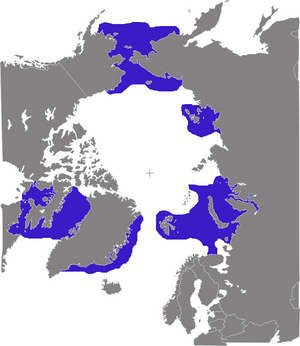 |
|
| Distribution of walrus | |
| Synonyms | |
The walrus (Odobenus rosmarus) is a very large pinniped marine mammal. It lives around the North Pole in the Arctic Ocean and colder seas of the Northern Hemisphere. It is the only living species in its family, called Odobenidae. There are two main types, or subspecies: the Atlantic walrus, found in the Atlantic Ocean, and the Pacific walrus, found in the Pacific Ocean.
Adult walruses are easy to spot because of their long tusks and thick whiskers. They are also very big! Adult males in the Pacific can weigh over 2,000 kilograms (4,400 pounds). Among all pinnipeds (like seals and sea lions), only elephant seals are bigger. Walruses usually live in shallow waters near continental shelves. They spend a lot of time on sea ice looking for food. Walruses live a long time and are social animals. They are considered a "keystone species" in the Arctic. This means they are very important to their ecosystem.
Walruses have been important to many Arctic peoples for a long time. These people hunted them for meat, fat, skin, tusks, and bones. In the 1800s and early 1900s, many walruses were hunted for their blubber, walrus ivory, and meat. This caused their numbers to drop quickly across the Arctic. Since then, their populations have grown back a bit. However, Atlantic and Laptev walruses are still much fewer than they used to be.
Contents
What's in a Name?
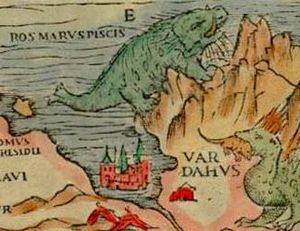
The word walrus comes from a Germanic language. It might come from Old Norse words like hvalr (meaning 'whale') and hross (meaning 'horse'). So, it could mean 'horse-whale'. Another idea is that it comes from Dutch words meaning 'shore giant'.
The scientific name rosmarus is from Scandinavia. An old Norwegian book from around 1240 AD called the walrus rosmhvalr in Iceland.
An older English word for walrus was morse. This word likely came from Slavic languages, which got it from other languages in Northern Europe. For example, in Russian, it's morž, and in Finnish, it's mursu.
The name Odobenus comes from ancient Greek words. Odous means 'teeth' and baino means 'walk'. This name came from people seeing walruses use their tusks to pull themselves out of the water. The word divergens in Latin means 'turning apart', which describes how their tusks grow.
Walrus Family Tree
The walrus is a mammal and belongs to the group called Carnivora. It is the only living member of its family, Odobenidae. This family is part of a larger group called Pinnipedia, which also includes true seals and eared seals. Scientists believe all these animals came from a common ancestor related to modern bears.
There are two main types of walruses that scientists agree on:
- The Atlantic walrus (O. r. rosmarus)
- The Pacific walrus (O. r. divergens)
These two types have small genetic differences. This shows they don't mix much and separated a long time ago, between 500,000 and 785,000 years ago. This fits with the idea that walruses started in warmer waters and slowly adapted to the cold Arctic.
Walruses used to live in more places. Fossils have been found as far south as San Francisco and North Carolina.
Some people used to think there was a third type in the Laptev Sea. But now, scientists believe these walruses are actually part of the Pacific walrus group.
Walrus Body Features
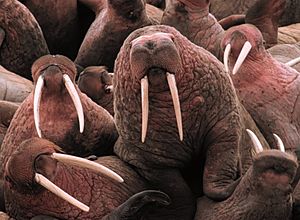

Some very large Pacific male walruses can weigh up to 2,000 kg (4,400 lb). Most walruses weigh between 800 and 1,700 kg (1,800 and 3,700 lb). The Atlantic walrus is a bit smaller, weighing about 10–20% less than the Pacific type. Male Atlantic walruses average 900 kg (2,000 lb). Females are about two-thirds the size of males.
Walruses are usually 2.2 to 3.6 m (7 ft 3 in to 11 ft 10 in) long. Newborn walruses are already quite big, weighing 33 to 85 kg (73 to 187 lb). Overall, the walrus is the third largest pinniped, after the two types of elephant seals. Walruses have a lot of blubber (fat) under their skin. This blubber keeps them warm and gives them energy.
Walruses can move on land using all four flippers, like sea lions. But when they swim, they move their whole body like true seals. Unlike sea lions, they don't have outside ears.
Walruses have good eye muscles. This lets them stick their eyes out and see both forward and upward. However, their vision is best for seeing things close up.
Tusks and Teeth
The most famous part of a walrus is its long tusks. These are actually very long canine teeth. Both male and female walruses have tusks. They can grow up to 1 m (3.3 ft) long and weigh up to 5.4 kg (12 lb). Male tusks are usually a bit longer and thicker. Males use them for fighting and showing who is strongest. Walruses also use their tusks to make and keep holes in the ice. They also help the walrus climb out of the water onto the ice.
People once thought walruses used their tusks to dig for food on the seabed. But studies show they drag their tusks through the mud while using their snout to dig. Walruses don't have many other teeth besides their tusks.
Whiskers (Vibrissae)
Around their tusks, walruses have a thick mat of stiff bristles called vibrissae (whiskers). This gives them their classic whiskered look. They can have 400 to 700 whiskers in many rows. These whiskers can be 30 cm (12 in) long, but they often get shorter from constant use while looking for food. The whiskers are connected to muscles, blood, and nerves. This makes them very sensitive. They can feel objects as thin as 3 mm (0.12 in).
Skin
Walruses have very little fur and look mostly bald. Their skin is very wrinkled and thick, up to 10 cm (3.9 in) thick around the neck and shoulders of males. Underneath, they have a blubber layer up to 15 cm (5.9 in) thick. Young walruses are dark brown. As they get older, they become paler and more cinnamon-colored. Old males can even look almost pink. When they are in cold water, their skin blood vessels tighten, making them look almost white. Older males also get bumpy growths, called "bosses," especially around their neck and shoulders.
Walruses have an air sac under their throat. This sac acts like a float, letting them bob upright in the water and even sleep there.
Walrus Life Cycle

Reproduction
Walruses usually live for about 20–30 years in the wild. Males can become ready to mate as early as seven years old. However, they usually don't mate until they are fully grown, around 15 years old. Walruses mate in the water, mostly from January to March.
Pregnancy lasts for 15 to 16 months. Calves (baby walruses) are born during the spring migration, from April to June. They weigh 45 to 75 kg (99 to 165 lb) at birth and can swim right away. Mothers nurse their calves for over a year. Young walruses can stay with their mothers for up to five years. Walrus milk has a lot of fat and protein. Females usually give birth only every two years. This means walruses have one of the slowest reproduction rates of any pinniped.
Migration
During late summer and fall, walruses often gather in huge groups of tens of thousands of animals. They gather on rocky beaches or outcrops. Their migration between the ice and the beach can be very long. For example, in late spring and summer, hundreds of thousands of Pacific walruses travel from the Bering Sea to the Chukchi Sea. They pass through the narrow Bering Strait.
Walrus in the Wild
Where Walruses Live
Most Pacific walruses spend their summers north of the Bering Strait in the Chukchi Sea. This is along the northern coast of eastern Siberia and around Wrangel Island. They also live in the Beaufort Sea along the northern shore of Alaska. In spring and fall, they gather around the Bering Strait. In winter, they stay in the Bering Sea.
In the 1950s and 1960s, hunting reduced the Pacific walrus population to between 50,000 and 100,000. Hunting limits helped the population grow to over 220,000 in the 1970s and 1980s. However, their numbers have since dropped again. In 2006, the Pacific walrus population was estimated to be around 129,000. There were about 200,000 in 1990.
The Atlantic walrus population is much smaller. They live in the Canadian Arctic, Greenland, Svalbard, and western Arctic Russia. They used to live as far south as Nova Scotia. In the 1700s, large groups of 7,000 to 8,000 walruses were found in the Gulf of Saint Lawrence. Commercial hunting almost wiped out this population. Their current numbers are probably less than 20,000.
An isolated group of walruses lives in the Laptev Sea. Their population is estimated to be between 5,000 and 10,000.
Walruses can dive very deep, sometimes over 500 meters. But they usually stay in shallow waters, near ice floes, to hunt for food.
Sometimes, walruses wander far from their usual homes. In March 2021, a walrus nicknamed Wally the Walrus was seen in Ireland. This was far south of its normal range. It might have fallen asleep on an iceberg that drifted south. In June 2022, a walrus was seen in the Baltic Sea in Germany, Poland, and Sweden. Another lost walrus was reported in Finland in July 2022.
What Walruses Eat
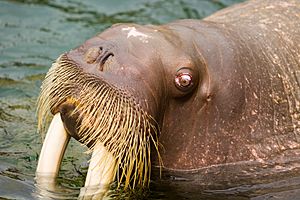
Walruses prefer shallow areas on the sea floor. They mostly find food by searching the bottom of the sea, often from ice platforms. They don't dive as deep as some other pinnipeds.
Walruses eat many different marine animals, over 60 types! This includes shrimp, crabs, tube worms, soft corals, tunicates, sea cucumbers, and various mollusks like clams, snails, octopuses, and squid. They also eat some slow-moving fish. Sometimes, they even eat parts of other seals.
They especially love bivalve mollusks, like clams. They find these by grazing along the sea bottom. They use their sensitive vibrissae (whiskers) to find prey. They can clear the muddy bottom with jets of water and by moving their flippers. The walrus sucks the meat out of clams by sealing its powerful lips around the shell. Then, it quickly pulls its tongue back, creating a vacuum. The roof of a walrus's mouth is specially shaped for this suction.
Walrus foraging also affects the sea floor. They disturb the bottom, which releases nutrients into the water. This helps other organisms move around and mix.
Sometimes, walruses eat seals. This happens more often with Pacific walruses. There have been rare sightings of walruses eating seabirds. Walruses might also eat narwhals stuck in ice or scavenge on whale carcasses.
Who Hunts Walruses?
Because of their large size and tusks, walruses have only two natural predators: the orca (killer whale) and the polar bear. However, walruses are not a major part of either predator's diet. Orcas and polar bears are most likely to hunt walrus calves.
Polar bears sometimes hunt walruses by rushing at large groups on the beach. They try to catch young or sick animals that get crushed or hurt in the rush. Bears also try to catch walruses when they are stuck in the ice and can't escape into the water. But even an injured walrus is a tough opponent for a polar bear. Direct attacks are rare. Walruses have been known to fatally injure polar bears with their tusks if the bear follows them into the water, where the walrus has an advantage. Battles between polar bears and walruses can be very long and tiring. Bears sometimes give up after hurting a walrus. Orcas also attack walruses. Walruses are believed to have fought back successfully against orcas. But orcas have also been seen successfully attacking walruses with few injuries.
Walruses and People
Protecting Walruses
In the 1700s and 1800s, many walruses were hunted by American and European sealers and whalers. This almost made the Atlantic walrus disappear. By 1871, traditional hunters were already worried about how many walruses were being hunted. Now, commercial walrus hunting is against the law everywhere they live. However, Chukchi, Yupik, and Inuit peoples are allowed to hunt a small number of walruses each summer.
Traditional hunters used every part of the walrus. The meat was an important food source in winter. Flippers were fermented as a special treat. Tusks and bones were used for tools and crafts. Oil from their blubber provided warmth and light. Their tough hide was used for ropes and coverings for houses and boats. Their intestines were even used to make waterproof parkas. While some of these uses have changed with new technologies, walrus meat is still an important part of local diets. Carving and engraving tusks is still a very important art form.
Adolf Erik Nordenskiöld, an explorer, said that European hunters didn't find walrus meat very tasty. They only ate it if they had to. However, walrus tongue was considered a delicacy.
-
Trained walrus in captivity at Marineland
Walrus hunting is managed by governments in Russia, the United States, Canada, and Greenland. About 4,000 to 7,000 Pacific walruses are hunted each year in Alaska and Russia. This includes many animals that are hit but lost. Several hundred are also hunted around Greenland each year. It's hard to know if these hunting levels are sustainable because population numbers are uncertain.
Global climate change is another big worry. The amount and thickness of sea ice have been unusually low in recent years. Walruses rely on this ice for giving birth and gathering during their breeding season. Less ice in the Bering Sea means less resting space near good feeding areas. This separates mothers from their calves more often, which makes it harder for the young to get enough food and lowers reproduction rates. Less coastal sea ice has also led to more walruses dying from stampedes. This happens when too many walruses crowd onto shorelines in the Chukchi Sea. Studies show that Pacific walrus populations will likely keep declining and move further north. But careful conservation could help limit these effects.
Currently, two of the three walrus subspecies are listed as "least-concern" by the IUCN. This means they are not in immediate danger. The third subspecies is "data deficient," meaning there isn't enough information about it. In Russia, the Atlantic and Laptev Sea walrus populations are listed as decreasing or rare. Trading walrus ivory globally is restricted by CITES. In 2017, a group called the Center for Biological Diversity sued the U.S. government to make them list the Pacific Walrus as a threatened or endangered species.
In Svalbard, walruses were almost gone by 1952 due to ivory hunting. But the Norwegian government banned hunting, and their population started to grow back. By 2006, it had increased to 2,629.
Walruses in Stories
Folklore
The walrus is important in the religion and folklore of many Arctic peoples. Their skin and bones are used in some ceremonies. The animal often appears in legends. For example, in a Chukchi story, a girl turns into a walrus when she falls into the water. Her tusks are said to be made from her tears or long braids. This story might be linked to the Inuit goddess Sedna, who rules the bottom of the sea. In both Chukotka and Alaska, people believe the aurora borealis (Northern Lights) is a special world where people who died violently play ball with a walrus head.
-
John Tenniel's drawing for Lewis Carroll's poem "The Walrus and the Carpenter"
-
Dutch explorers fighting a walrus on the coast of Novaya Zemlya, 1596
Many of the famous 12th-century Lewis Chessmen from northern Europe are carved from walrus ivory.
Literature
Because of its unique look, large size, and famous whiskers and tusks, the walrus appears in popular culture. This is true even for people who have never seen one. It's especially popular in English children's books.
Perhaps its most famous appearance is in Lewis Carroll's poem "The Walrus and the Carpenter". This poem is in his 1871 book Through the Looking-Glass. In the poem, the walrus and the carpenter trick many oysters into being eaten. While Carroll correctly shows the walrus's love for bivalve mollusks, oysters usually live near the shore. They are not a big part of a walrus's diet in the wild.
The "walrus" in the Beatles song "I Am the Walrus" is a reference to this Lewis Carroll poem.
Another appearance of the walrus in literature is in the story "The White Seal" from Rudyard Kipling's The Jungle Book. Here, the walrus is described as "the big, ugly, bloated, pimpled, fat-necked, long-tusked walrus of the North Pacific, who has no manners except when he is asleep."
|
See also
 In Spanish: Morsa para niños
In Spanish: Morsa para niños




